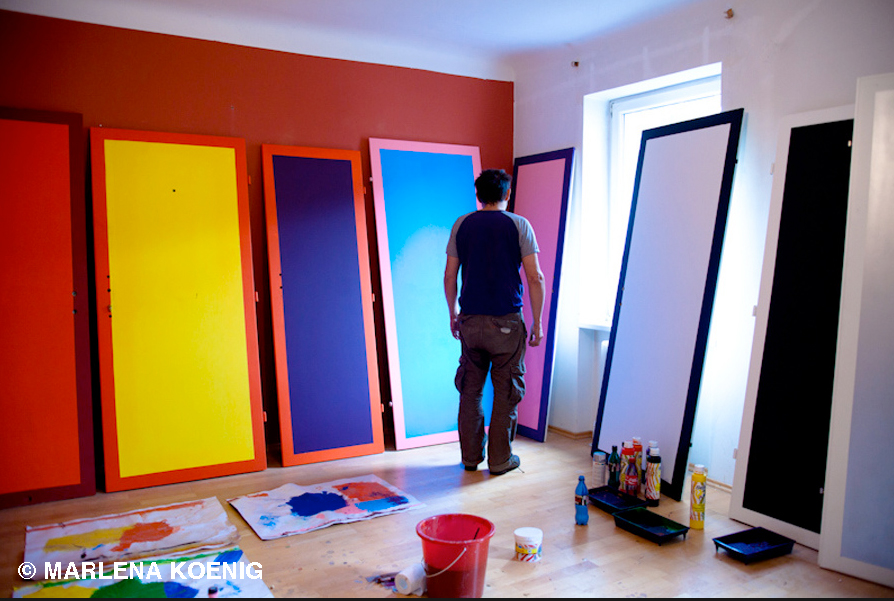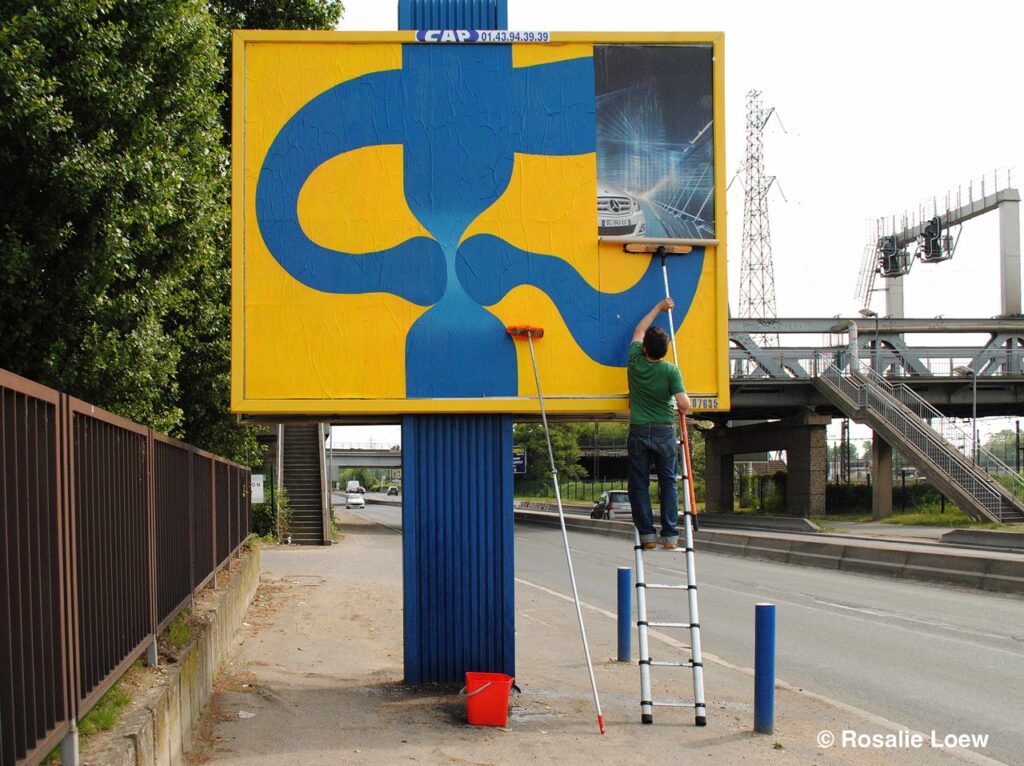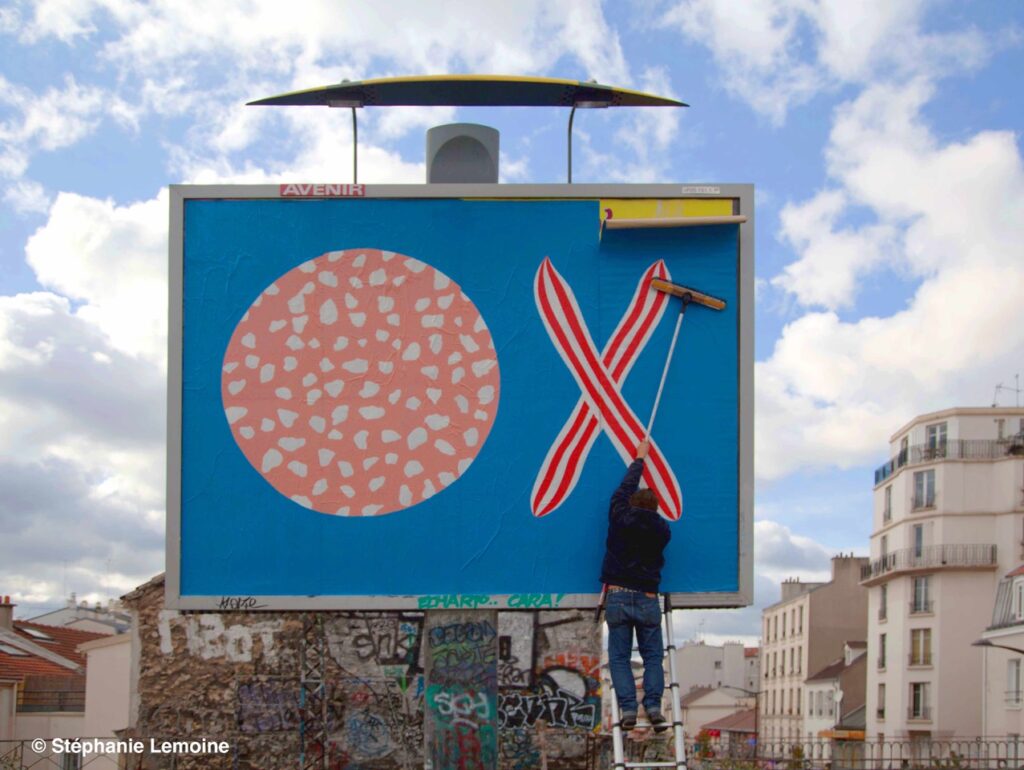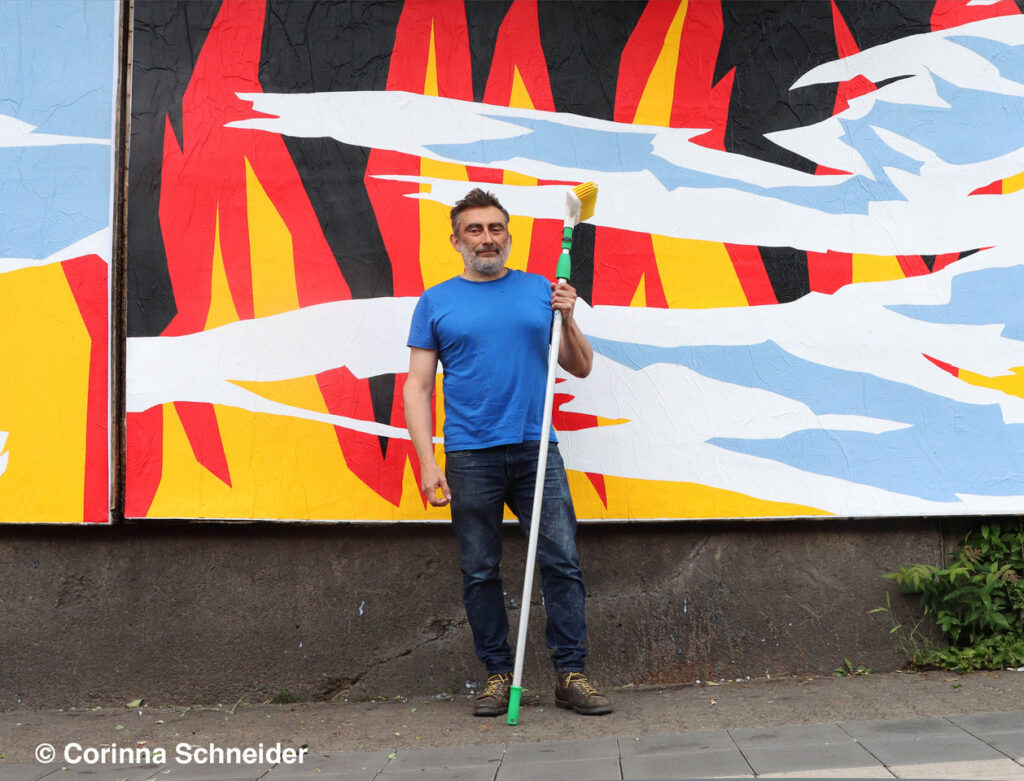Partout où il intervient, OX décline une même obsession : la mise en question et le débordement du cadre où ses œuvres viennent s’inscrire. Parce qu’il crée à même la ville depuis près de quarante ans, on le campe volontiers en pionnier de l’art urbain. Mais il est plus spécifiquement un artiste contextuel en quête d’un lien juste avec son environnement, et qui mobilise à cette fin une grande diversité de formes et de registres.
Il y a bien sûr les affichages sauvages : depuis sa participation à l’aventure collective des Frères Ripoulin entre 1984 et 1987, OX a investi un très grand nombre de panneaux 4 x 3. Selon un protocole allant du repérage sur site à l’élaboration dans l’atelier d’une affiche peinte à la main, il s’attache à prolonger à l’intérieur du cadre publicitaire un hors-cadre rythmé par l’architecture, la végétation, le mobilier urbain, les infrastructures, les flux et les réseaux. Collées in situ, ses affiches charrient toutes sortes de références visuelles. Abstraction, figuration, publicité ou signalétique y sont maniées et réinterprétées au service d’un jeu délibéré avec l’espace alentour. Un dernier cadrage vient ensuite révéler les systèmes d’échos, mises en abyme et contrepoints orchestrés par l’artiste : la photographie de l’intervention. Celle-ci n’est pas, ou secondairement, une archive : entre la peinture et sa saisie sous forme de cliché, les œuvres de OX renouvellent le genre du paysage et nouent un dialogue fécond entre site et non-site, entre champ et hors champ.
La négociation de l’artiste avec le cadre se joue aussi dans ses travaux d’atelier. Depuis les années 1990, OX prend à revers la toile, médium roi de la peinture. Il en renégocie les constituants essentiels en puisant aussi bien dans l’héritage de Supports/Surface que dans les cultures de masse et l’imagerie commerciale. Au gré d’opérations diverses (sélection, soustraction, déconstruction, assemblage…), ses œuvres défont la planéité de la toile et l’inclinent vers la sculpture et l’installation.
Cette réflexivité n’est jamais exempte d’humour. Elle affirme sans tapage, en toute discrétion, le primat du fait main et la liberté de déborder toutes les limites. A commencer par celles qui confinent l’art dans le bon goût et l’esprit de sérieux.
Les oeuvres de OX ont été exposées chez Tony Shafrazi (1985), à la Galerie du Jour (1985, 2013), au Centre Georges Pompidou (Ex Situ, 2013), sur les façades du Ministère de la culture (Oxymore, 2015), à la Fabien Castanier Gallery à Los Angeles (2016), à la Fondation Leclerc à Landernau (Libres figurations, 2018), au Street art museum de Saint-Petersburg (2019), à la Fab. (2020) et au musée des Beaux-arts de Rennes (2021).
Sa stature de “pionnier de l’art urbain” et son approche contextuelle lui ont aussi valu de participer à de nombreux festivals, parmi lesquels Black River à Vienne (2010), Bien Urbain à Besançon (2011, 2013 et 2021), Ms Artsville à Hambourg (2018), Nuart à Stavanger (2019), Urban art Biennale à Völklingen (2019), Rouen impressionnée (2020) et Teenage kicks à Rennes (2021).
Wherever he works, OX has the same obsession: to challenge and transcend the context of his artworks. Having created works in the same city for nearly forty years, he is often portrayed as a pioneer of urban art. But he is more specifically looking to play with the context, and to do so he draws from a wide range of forms and sources.
There are, of course, the unauthorised posters: since his involvement in the eccentric, spontaneous Frères Ripoulin collective between 1984 and 1987, OX has invested a great number of 4×3 billboards. Following a protocol that includes location scouting and painting posters in the studio, he is focused on extending beyond the advertising frame into an environment marked by architecture, vegetation, street furniture, infrastructure, flows and networks. Pasted in situ, his posters draw from a wide range of visual references. Abstraction, figuration, advertising and signage are combined and reinterpreted to provoke a confrontation with the surrounding space, moving between integration and disruption. A final frame then reveals the gaps, overlaps, mise-en-abyme and contradictions orchestrated by the artist: the photograph of the intervention. This is both an archive and a deconstruction of the scene, suddenly purged of the banal urban context (passers-by, cars, advertisements…). By pairing painting with photography, OX’s work renews the landscape genre and engages in a fertile dialogue between site and non-site.
The artist’s negotiation with the frame is also at play in his studio work. Since the 1990s, OX has confronted the canvas, painting’s ultimate medium. He renegotiates its essential components and materials, aiming, in his words, for a ‘decorative painting’ that derives as much from the artistic movements of the second half of the twentieth century as from mass culture and commercial imagery. Through a variety of processes (selection, subtraction, deconstruction, assembly, etc.), his artworks break down the flatness of the canvas, leaning towards sculpture and installation. Paintings become objects and environments.
This reflexivity is never without a sense of humour. In a facetious, almost childlike way, it asserts the primacy of the handmade and the freedom to go beyond all limits… Beginning with those that confine art to good taste and solemnity.
Expositions / Shows
- Build a home (
Du 26 février au 24 mars (Amsterdam)
) - METZ (
2023 Blister
) - Kelderman en van Noort / KEVN (
Eindhoven, avril 2023
) - Niort (
2022
)
Prospectus - Turin (
2022
)
Illusione Collettiva - Katovitce (
2021
) - Los Angeles Fabien Castanier (
2016
)
Transborder - Lille New Square gallery (
2015
)
Tout doit disparaître - Berlin open walls (
2015
)
Position - Berlin Open Walls (
2014
)
Positions - Paris (
2014
) - Paris Galerie Beaubourg (
2008
) - Munich (
2011
)



